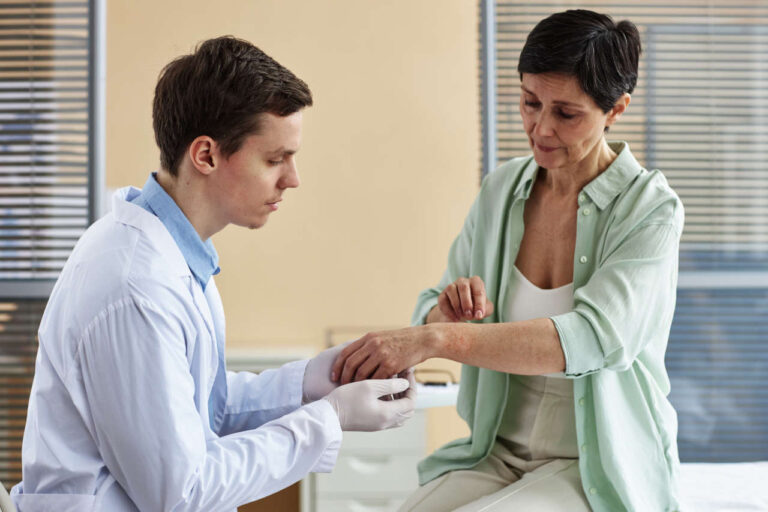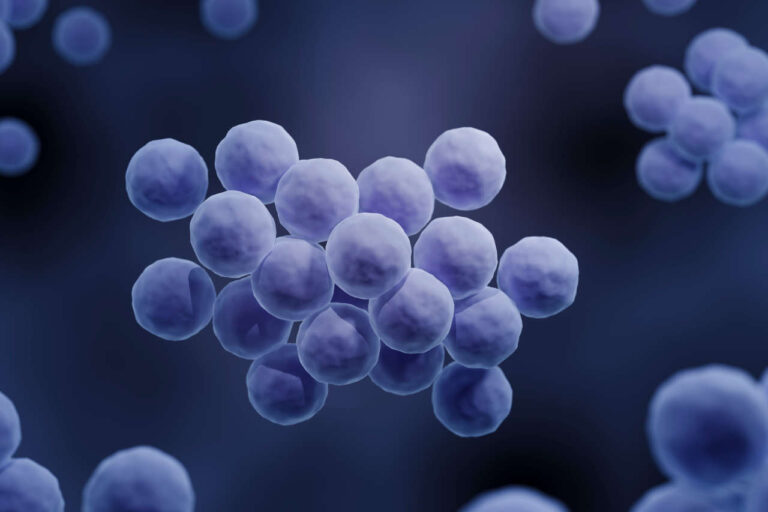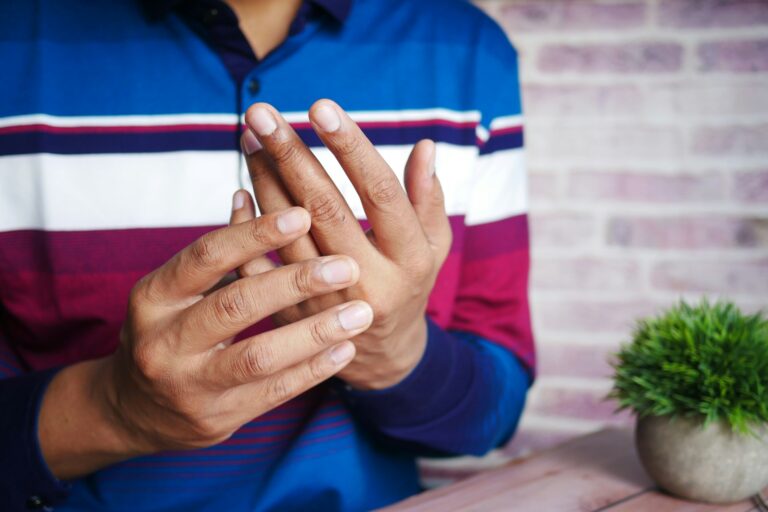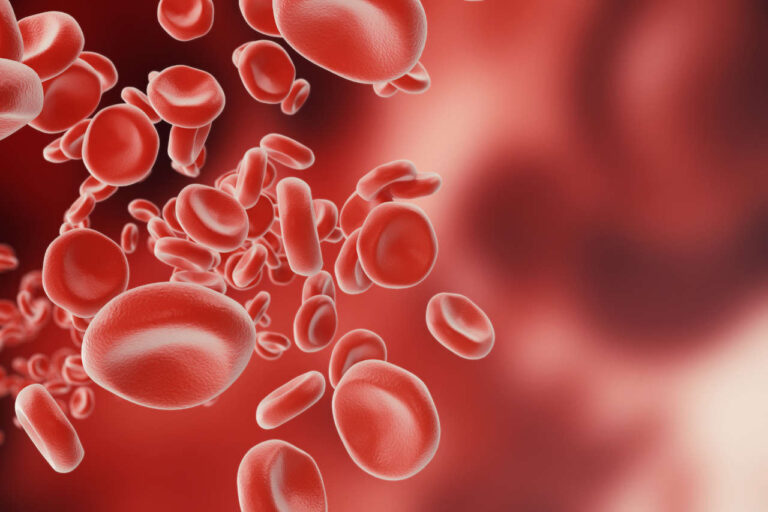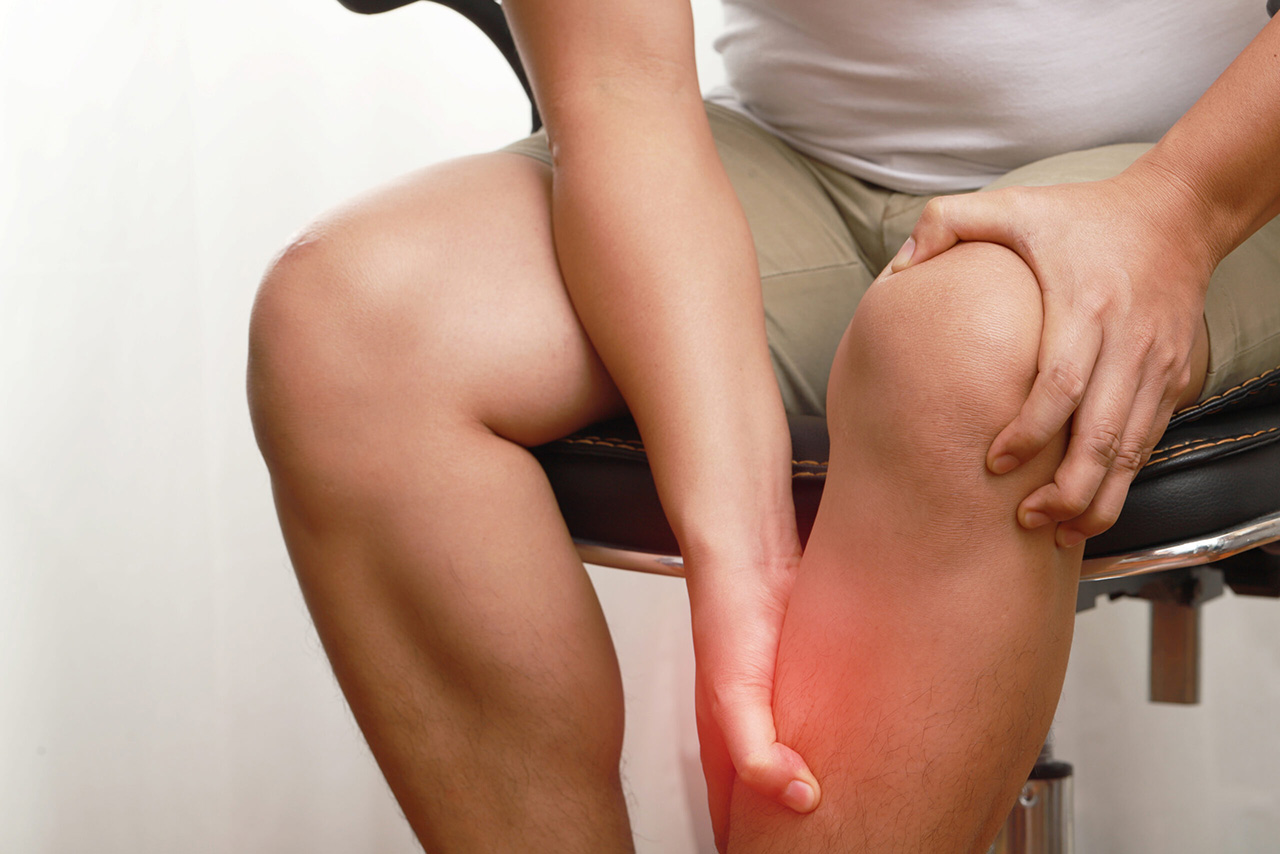
Viêm cơ có nguồn gốc từ hai từ: “tôi,” nghĩa là cơ bắp, và “nó,” nghĩa là viêm. Do đó, viêm cơ chỉ một nhóm bệnh gây viêm cơ.
Các triệu chứng của bệnh viêm cơ bao gồm đau, sưng và suy nhược toàn thân.
Nguyên nhân nào gây ra bệnh viêm cơ?
Nhiều người đã từng bị đau nhức cơ khởi phát muộn (DOMS) sau khi tập thể dục gắng sức, nhưng tình trạng này chỉ là tạm thời và sẽ giảm dần khi nghỉ ngơi. Các nguyên nhân khác gây viêm cơ bao gồm nhiễm trùng, chấn thương cơ do thuốc, bệnh di truyền, bệnh tự miễn, mất cân bằng điện giải, bệnh tuyến giáp và tác dụng phụ của thuốc.
Viêm cơ thường được dùng để chỉ tình trạng viêm mãn tínhMộtbệnh lý chủ yếu là kết quả của các tình trạng tự miễn dịch Trong đó hệ thống miễn dịch của cơ thể bắt đầu tấn công các mô của chính nó. Viêm cơ do các bệnh tự miễn còn được gọi là viêm cơ vô căn (IIM). Khác với các loại bệnh cơ khác, IIM nghiêm trọng hơn và đi kèm với các biến chứng nghiêm trọng.
Các loại viêm cơ
Các loại viêm cơ khác nhau có thể được phân loại theo bốn loại phụ:
- Viêm đa cơ (Thủ tướng)
- Viêm da cơ (DM)
- Bệnh cơ hoại tử do miễn dịch (IMNM)
- Viêm cơ thể vùi rải rác (sIBM)
Nhận hỗ trợ đồng thanh toán IVIG
Hỗ trợ tài chính IVIGViêm đa cơ (PM)
Viêm đa cơ thường ảnh hưởng đến người lớn trong độ tuổi từ 30 đến 50 và phổ biến hơn ở phụ nữ so với nam giới. Bệnh ảnh hưởng đến nhiều nhóm cơ (“poly” có nghĩa là nhiều), phổ biến nhất là các nhóm cơ gần thân mình (ví dụ: vai, cánh tay trên, cổ, lưng trên, đùi, hông và vùng đùi). Yếu cơ sẽ bắt đầu từ những cơ này và có thể lan sang các bộ phận khác của cơ thể.
Bệnh nhân PM cũng có thể gặp các vấn đề về hô hấp và khó nuốt nếu các cơ ở thành ngực hoặc cổ bị ảnh hưởng.
Viêm da cơ (DM)
Viêm da cơ có thể ảnh hưởng đến mọi lứa tuổi và giới tính, nhưng phổ biến ở phụ nữ hơn nam giới. Viêm da cơ có thể xảy ra ở trẻ em, trong trường hợp này được gọi là viêm da cơ vị thành niên. Giống như viêm đa cơ, viêm da cơ khiến cơ bị viêm ở nhiều vùng, nhưng bắt đầu bằng phát ban trên cơ thể và da khô, có vảy. Các phát ban chủ yếu ở mí mắt, mũi, má, lưng, ngực trên, khuỷu tay, đầu gối và khớp ngón tay.
Bệnh cơ hoại tử do miễn dịch (IMNM)
IMNM đặc trưng bởi các dấu hiệu hoại tử, hoặc chết tế bào, ở cơ, dẫn đến suy nhược và mệt mỏi nghiêm trọng. Người mắc bệnh cơ hoại tử thường bị yếu cơ ở phần thân trên (cẳng tay, đùi, hông, vai, cổ và lưng).
Viêm cơ thể vùi rải rác (sIBM)
sIBM là bệnh cơ phổ biến nhất ở những người trên 50 tuổi và phổ biến ở nam giới hơn nữ giới. Không giống như các loại viêm cơ khác, các triệu chứng của sIBM phát triển dần dần trong nhiều năm. Vì lý do này, bệnh nhân có thể gặp các triệu chứng trong nhiều năm trước khi được chẩn đoán.
Người mắc chứng bệnh này gặp khó khăn khi thực hiện các hoạt động thường ngày, chẳng hạn như đi bộ và leo cầu thang. Các cơ thường bị ảnh hưởng nhất là các cơ ở phía trước đùi, các cơ nâng bàn chân, và các cơ ở hông, ngón tay, cổ tay, cánh tay trên, vai, cổ và lưng. Nhiều bệnh nhân sẽ nhận thấy cánh tay và đùi bị teo lại khi các cơ trở nên yếu hơn. sIBM thường không đáp ứng với liệu pháp ức chế miễn dịch, không giống như các bệnh cơ viêm khác.
Triệu chứng viêm cơ
Vì viêm cơ chủ yếu liên quan đến mô cơ, yếu cơ là triệu chứng phổ biến nhất. Các triệu chứng khác bao gồm sưng cơ và đau.
Hầu hết các triệu chứng của viêm cơ đều trở nên nặng dần theo thời gian. Người bị viêm cơ có thể cảm thấy đau hoặc không đau lúc đầu, nhưng tình trạng yếu cơ và mệt mỏi sẽ ảnh hưởng xấu đến chất lượng cuộc sống. Các nhóm cơ lớn, đặc biệt là các cơ nâng đỡ vai, hông, đùi, lưng và cổ, bị ảnh hưởng đáng kể.
Theo thời gian, tình trạng yếu cơ trở nên nghiêm trọng đến mức làm gián đoạn chuyển động bình thường, dẫn đến té ngã, khó đứng dậy sau khi bị ngã, khó leo cầu thang và khó đứng dậy khỏi ghế.
Thông tin điều trị
Nhận được sự cho phép trước của IVIGNguyên nhân gây viêm cơ
Nhiễm trùng
Các nguyên nhân truyền nhiễm phổ biến nhất Viêm cơ là do nhiễm virus. Hiếm khi, các tác nhân khác như vi khuẩn và nấm cũng có thể gây viêm cơ. Virus hoặc vi khuẩn xâm nhập trực tiếp vào mô cơ hoặc giải phóng các chất gây tổn thương cơ.
Chấn thương
Tập thể dục mạnh có thể dẫn đến đau cơ, sưng và yếu cơ trong nhiều ngày sau khi tập luyện. Tình trạng viêm góp phần gây ra các triệu chứng này, khiến nó trở thành một dạng viêm cơ. Các triệu chứng viêm cơ và chấn thương sau khi tập luyện thường tự khỏi hoàn toàn khi nghỉ ngơi.
Ma túy
Một số loại thuốc có thể gây tổn thương cơ tạm thời. Bao gồm:
Statin: Statin là một nhóm thuốc hạ cholesterol. Các tác dụng phụ nghiêm trọng có thể xảy ra bao gồm viêm cơ và tiêu cơ vân. Những người đang dùng statin được khuyến cáo tránh dùng nước ép bưởi vì nó có thể cản trở khả năng phân hủy thuốc statin của cơ thể. Điều này có thể dẫn đến tăng nồng độ statin trong máu, có thể dẫn đến các tác dụng phụ.
Colchicin: Colchicine thường được sử dụng để ngăn ngừa hoặc điều trị các đợt bùng phát bệnh gút. Một trong những tác dụng phụ hiếm gặp của việc dùng colchicine là bệnh cơ. Các triệu chứng của bệnh cơ tương tự như triệu chứng của bệnh viêm cơ.
Plaquenil: Plaquenil được sử dụng để phòng ngừa hoặc điều trị sốt rét do muỗi đốt. Thuốc cũng được sử dụng để điều trị bệnh lupus ban đỏ hoặc viêm khớp dạng thấp. Tác dụng phụ có thể xảy ra là bệnh cơ (bao gồm liệt hoặc bệnh thần kinh cơ). Tuy nhiên, cần lưu ý rằng bệnh cơ do Plaquenil rất hiếm gặp, nguy cơ càng cao khi dùng thuốc lâu dài và liều dùng càng cao. Do nguy cơ này, nên theo dõi định kỳ ở những người điều trị dài hạn.
Interferon alpha: Interferon alpha được sử dụng để điều trị nhiều loại ung thư và nhiễm virus như viêm gan B. Các tác dụng phụ có thể xảy ra bao gồm viêm cơ và bệnh cơ (bao gồm cả bệnh cơ tim).
Rượu bia: Uống rượu nhiều có liên quan đến bệnh cơ, gây ra các triệu chứng đau cơ và yếu cơ. Bệnh có thể cấp tính, sau khi một người uống quá nhiều rượu, hoặc mạn tính, phát triển theo thời gian do sử dụng rượu nhiều.
Cocaine: Cocaine là một chất gây nghiện cao, ảnh hưởng đến hệ thần kinh trung ương. Nó ảnh hưởng xấu đến các tế bào cơ và được biết đến là gây ra bệnh cơ và tiêu cơ vân.
Bệnh cơ có thể xảy ra ngay sau khi bắt đầu sử dụng một trong những loại thuốc này hoặc có thể xảy ra sau nhiều tháng đến nhiều năm sử dụng. Hầu hết các trường hợp đều có thể hồi phục khi ngừng thuốc nếu được phát hiện sớm.
Chẩn đoán viêm cơ
Có một loạt các khác nhau các xét nghiệm có thể giúp chẩn đoán viêm cơ. Bao gồm:
Xét nghiệm máu
Cơ bắp chứa một số protein liên tục được giải phóng vào máu khi cơ thể chúng ta tạo ra các tế bào mới và sửa chữa các tế bào bị tổn thương. Khi tổn thương tế bào cơ gia tăng, nồng độ những protein này tăng lên trong máu Ngoài ra, nồng độ protein cơ tăng cao có thể giúp chẩn đoán viêm cơ. Các protein nổi bật nhất được xét nghiệm trong viêm cơ là creatine kinase (CK) và aldolase. Các xét nghiệm máu khác, chẳng hạn như kháng thể kháng nhân (ANA), kiểm tra các kháng thể bất thường giúp xác định xem có tình trạng tự miễn dịch hay không.
Điện cơ đồ (EMG)
Nghiên cứu EMG kiểm tra phản ứng cụ thể của cơ với các tín hiệu thần kinh điện. Bằng cách này, EMG xác định các cơ yếu hoặc bị tổn thương do viêm cơ.
Sinh thiết cơ và sinh thiết da
Hai xét nghiệm này là những xét nghiệm chính xác nhất để chẩn đoán viêm cơ. Một vết rạch nhỏ được thực hiện và một mẫu nhỏ được lấy ra để xét nghiệm. Sinh thiết cơ và da thường là cách chẩn đoán viêm cơ chính xác nhất.
Chụp cộng hưởng từ
Chụp MRI là phương pháp không xâm lấn và sử dụng máy quét để tạo hình ảnh cơ. Chụp MRI có thể giúp xác định các vùng viêm cơ và những thay đổi của cơ theo thời gian.
Nhận hỗ trợ đồng thanh toán IVIG
Nói chuyện với một chuyên giaViêm cơ có chữa khỏi được không?
Hiện tại, chưa có cách chữa khỏi viêm cơ, nhưng bệnh có thể được kiểm soát để giảm viêm và ngăn ngừa tình trạng yếu cơ tiến triển. Một số loại thuốc và thay đổi lối sống có thể làm chậm quá trình tiến triển của bệnh.
Điều trị viêm cơ
Viêm cơ rất khác nhau ở mỗi bệnh nhân, vì vậy không có phương pháp điều trị duy nhất nào có hiệu quả với tất cả mọi người. Có nhiều loại thuốc có thể được sử dụng riêng lẻ hoặc kết hợp.
Thuốc ức chế miễn dịch
Thuốc ức chế miễn dịch là thuốc ức chế hoạt động của hệ miễn dịch và ngăn chặn các tế bào miễn dịch tấn công mô khỏe mạnh. Các thuốc ức chế miễn dịch được sử dụng trong điều trị viêm cơ bao gồm methotrexate, azathioprine, mycophenolate mofetil, cyclosporine, tacrolimus, cyclophosphamide và hydroxychloroquine.
Thuốc Corticosteroid
Corticosteroid bao gồm prednisone, methylprednisolone và các loại steroid khác.
Thuốc chống viêm
Thuốc kháng viêm không steroid (NSAID), chẳng hạn như aspirin và ibuprofen, giúp chống viêm và giảm đau trong bệnh viêm cơ.
Immunoglobulin tiêm tĩnh mạch (IVIG)
Liệu pháp sinh học đã trở nên phổ biến đáng kể trong vài năm trở lại đây. IVIG là một sản phẩm máu có nguồn gốc từ huyết tương của con người có chứa kháng thể giúp kiểm soát tình trạng viêm. Nó được coi là liệu pháp hiệu quả trong các thử nghiệm có kiểm soát ở những bệnh nhân bị viêm đa cơ, viêm da cơ và viêm cơ nhiễm trùng.
IVIG đặc biệt có lợi cho viêm da cơ và bệnh cơ hoại tử do miễn dịch. Tuy nhiên, bằng chứng lâm sàng về viêm đa cơ còn hạn chế. Ngoài ra, IVIG thường không được sử dụng trong sIBM.
Các phương pháp điều trị mới cho bệnh viêm cơ
Những tiến bộ gần đây trong điều trị viêm cơ đang mở rộng các lựa chọn cho những bệnh nhân không đáp ứng tốt với các liệu pháp thông thường như corticosteroid và thuốc ức chế miễn dịch. Một số liệu pháp mới nổi cho thấy nhiều triển vọng:
- Sinh học: Các liệu pháp nhắm mục tiêu như rituximab (kháng thể đơn dòng kháng CD20) đã cho thấy lợi ích ở một số bệnh nhân, đặc biệt là những người bị viêm da cơ hoặc viêm đa cơ không đáp ứng với điều trị tiêu chuẩn. Các thuốc sinh học khác đang được nghiên cứu bao gồm tocilizumab (thuốc đối kháng thụ thể IL-6) và abatacept (thuốc chẹn đồng kích thích tế bào T).
- Chất ức chế JAK: Đối với bệnh nhân viêm da cơ kháng trị, các chất ức chế Janus kinase (JAK), chẳng hạn như tofacitinib và ruxolitinib, đã cho thấy kết quả khả quan trong các nghiên cứu ban đầu. Các thuốc uống này hoạt động bằng cách điều chỉnh các con đường gây viêm và có thể giúp giảm viêm da và cơ.
- Liệu pháp gen và tế bào: Các thử nghiệm lâm sàng đang khám phá các kỹ thuật chỉnh sửa gen và liệu pháp tế bào, chẳng hạn như truyền tế bào gốc trung mô, đặc biệt là cho bệnh viêm cơ thể vùi rải rác (sIBM) và bệnh cơ hoại tử do miễn dịch (IMNM). Mặc dù vẫn đang trong giai đoạn thử nghiệm, các phương pháp này nhằm mục đích tái tạo mô cơ bị tổn thương hoặc điều chỉnh rối loạn miễn dịch tiềm ẩn.
Khi nghiên cứu tiếp tục, các liệu pháp cải tiến này có thể cung cấp các lựa chọn hiệu quả và cá nhân hóa hơn để điều trị các trường hợp viêm cơ khó.
Tham khảo ý kiến của chuyên gia IVIG
Truyền dịch IVIG tại nhà tốt nhất | Nhận hỗ trợ điều trị IVIGTuổi thọ của người mắc bệnh viêm cơ là bao nhiêu?
Tiên lượng cho các dạng viêm cơ khác nhau rất khác nhau và có thể phụ thuộc vào sự hiện diện của các bệnh lý khác. Mặc dù viêm cơ thể vùi rải rác là một bệnh tiến triển, tuổi thọ trung bình thường giống như những người không mắc bệnh. Tuy nhiên, đối với viêm da cơ, viêm đa cơ và bệnh cơ hoại tử, tiến triển của bệnh phức tạp hơn và khó dự đoán hơn.
Theo Hiệp hội Viêm cơHơn 95% trong số những bệnh nhân này vẫn còn sống hơn năm năm sau khi được chẩn đoán. Nhiều người chỉ trải qua một giai đoạn bệnh cấp tính trong đời, trong khi những người khác phải vật lộn với các triệu chứng trong nhiều năm.
Làm sao để biết mình bị viêm cơ?
Yếu cơ là triệu chứng chính của viêm cơ. Trong viêm cơ, tình trạng yếu cơ trở nên trầm trọng hơn qua nhiều tuần, nhiều tháng và ảnh hưởng đến các nhóm cơ lớn, bao gồm cổ, vai, hông và lưng. Cơ ở cả hai bên thường bị ảnh hưởng.
Người bị viêm cơ thường gặp khó khăn khi đứng dậy khỏi ghế hoặc leo cầu thang. Nếu bạn bị yếu cơ tiến triển, có hoặc không kèm theo đau cơ, tốt nhất bạn nên tham khảo ý kiến bác sĩ ngay lập tức.
Viêm cơ có thể tự khỏi không?
Giống như các bệnh viêm và tự miễn khác, viêm cơ không tự khỏi. Do đó, việc điều trị tập trung vào việc bảo tồn mô cơ bằng cách làm chậm tiến triển của bệnh, giảm đau cơ và cải thiện chất lượng cuộc sống.
Viêm cơ có thể gây tử vong không?
Viêm cơ là một bệnh tiến triển, nghĩa là bệnh sẽ nặng dần theo thời gian nếu không được điều trị tích cực. Nếu không được điều trị đúng cách, bệnh có thể dẫn đến tàn tật và cuối cùng là tử vong. Do đó, điều trị kịp thời là chìa khóa để làm chậm tiến triển và cải thiện chất lượng cuộc sống.
Tham khảo ý kiến của chuyên gia IVIG
Truyền dịch IVIG tại nhà tốt nhất | Nhận hỗ trợ điều trị IVIGViêm cơ có liên quan đến COVID-19 không?
Những phát hiện gần đây đã chỉ ra rằng COVID-19 có thể liên quan đến viêm cơ do virus. Viêm cơ do COVID-19 có thể biểu hiện khác nhau, từ viêm da cơ đến tiêu cơ vân.







